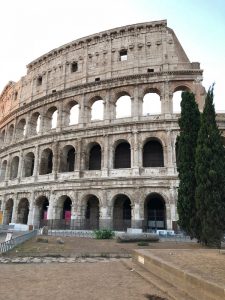Where were you, yesterday? Was the time you spent – where you were, doing what you did – spent, or invested?Whatever your answers to #1 and #2, here’s a stopper: can you prove it?
 Normally, this weekly musing arrives with my mug shot embedded at the top. Today, I’ve led-off with the iPhone shot from my Sunday sun-up walk through ancient Rome. Undoubtedly, you can name the edifice; everyone – whether they’ve walked the streets of the Eternal City or not – could pick the Coliseum out of a police line-up. It has no modern knock-off.
Normally, this weekly musing arrives with my mug shot embedded at the top. Today, I’ve led-off with the iPhone shot from my Sunday sun-up walk through ancient Rome. Undoubtedly, you can name the edifice; everyone – whether they’ve walked the streets of the Eternal City or not – could pick the Coliseum out of a police line-up. It has no modern knock-off.
It was bigger than any modern megachurch; seats for 80,000, with the ability to stage mock naval battles – or wild animal hunts (they had particular affection for killing African lions, up to 100 at a time), or athletic competitions, or gladiatorial contests, or dramatic re-enactments of military victories.
Originally known as Amphitheatrum Flavium, it was named for the emperors of the Flavian dynasty, following the reign of Nero. A monstrous statue of Nero stood outside the megalithic structure that was patterned after the Colossus of Rhodes (one of the Seven Wonders of the Ancient World; built in 280BC, the Colossus of Rhodes collapsed from an earthquake in 226BC and was never rebuilt – time spent: 56 years). That statue was the basis for the nickname ultimately given to the stadium: the Coliseum was the moniker that stuck.
In Rome, a statue produced the colloquial name for an epic structure; in America, our culture produces catch-phrases from movie screens. The 1976 docu-drama All the President’s Men coined the phrase, “Follow the Money.” The concept is clear: if you want the real/whole story, track the cash and you’ll get the big picture.
Where did the Romans get the money to build that immense memorial? The answer: Titus – a Roman General who became Caesar from 79-81AD – led the siege of Jerusalem in 70AD that conquered the Jews, destroyed Solomon’s Temple… and brought the stolen wealth of Israel back to Rome to fund the construction of the massive monument. Time spent.
Less discussed is the incalculable worth of the captives who were displaced: 10,000 enslaved Jews were employed to quarry the marble at Tivoli, transport it 20 miles to the Coliseum site, and erect the testimony to Rome’s power and might. It was about 2000BC when Pharaoh had enslaved their ancestors to build his pyramids; now, again, God’s people were being forced to erect the marble declarations of the greatness of their human oppressors.
While the Roman hierarchy was constructing stone monuments declaring their power, there was an invisible movement expanding across their Empire. Led by people like Paul of Tarsus, they left no buildings in their wake that would draw tourists in the 2000s. The strategic difference that marked the leaders who were the followers of Jesus had staying power. Paul’s approach:“For we wanted to come to you – certainly I, Paul, did, again and again – but Satan blocked our way. For what is our hope, our joy, or the crown in which we will glory in the presence of our Lord Jesus when he comes? Is it not you? Indeed, you are our glory and joy.” (1 Thessalonians 2:18-20).
The Roman approach: conquer countries; enslave people; steal their riches… and then construct structures that would – forever – tell the story of human victory. The Christian approach: go to every country, share the truth that would forever free people from slavery, teach them what real riches are and what to do with the resources that seem so valuable, but are, in fact, so temporary. The result: a new divine force – the “Church” – that would, forever, tell the story of God’s ultimate victory.
Every significant building in Rome has the names of Emperors or Caesars or Popes who built lifeless formations that have crumbled with time. The superior approach: invest your life’s efforts in redeeming people who will live forever because of the imprint you made on them.
Rome is not the Eternal City; that’s Jerusalem. Buildings are not the ultimate memorial; the greatest testimony of one’s life is people brought to faith and life through Jesus Christ.
Bob Shank
Great analogy Bob. I’m doing my best to live it out.
Wow – history that I did not know!
BTY – beautiful pic!!!
Loved this, Bob!
Excellent message Bob